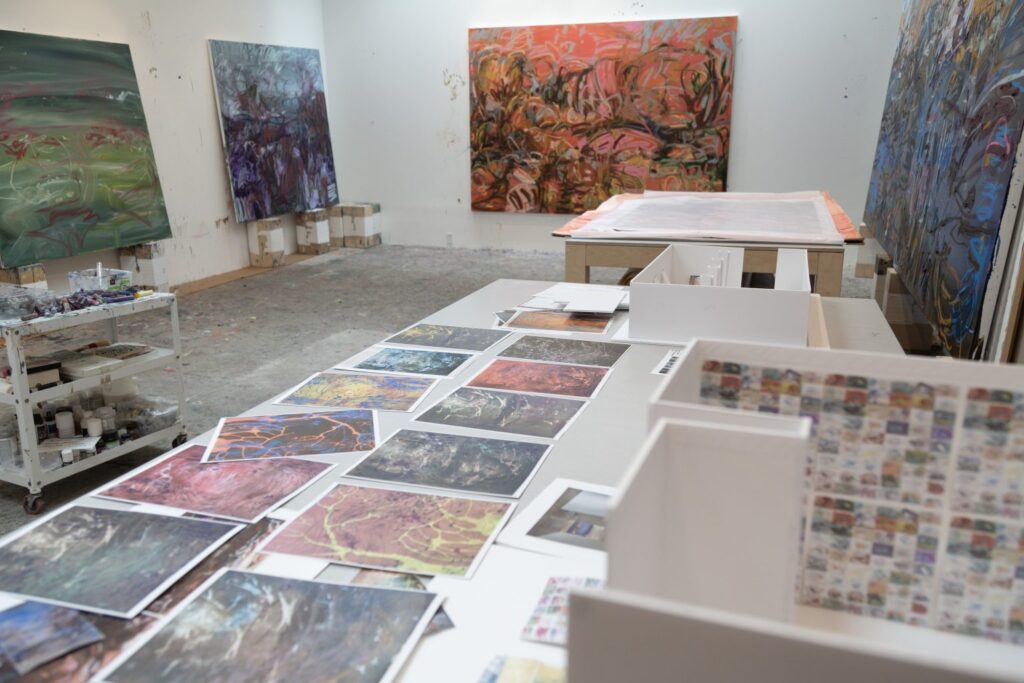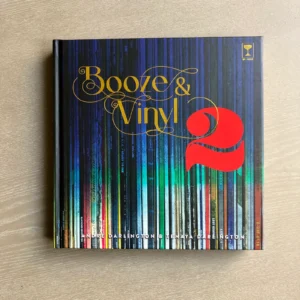Janaina Tschäpe, a German-Brazilian artist known for her ethereal and deeply sensory works, has once again captivated audiences with her latest exhibition, “A Sky Filled with Clouds and the Smell of Blood Oranges”, currently on view at Sean Kelly Gallery in New York. Tschäpe, whose multidisciplinary practice spans painting, drawing, video, photography, and installation, continues to explore themes of memory, nature, and the ephemeral in this new series. Her works evoke a dreamlike, atmospheric quality that beckons viewers to engage in an immersive experience where fragments of memory, emotion, and landscape collide.
In this critique, we’ll delve into the various aspects of Tschäpe’s latest works, focusing on their aesthetic qualities, thematic depth, and the emotional resonance they provoke. We’ll also explore how “A Sky Filled with Clouds and the Smell of Blood Oranges” fits within the broader trajectory of Tschäpe’s artistic career and its relevance to contemporary art discourse.
Visual Language: Lyrical Abstraction Meets Fragmented Memory
Tschäpe’s works in “A Sky Filled with Clouds and the Smell of Blood Oranges” are characterized by their fluidity and sense of movement. Large, abstract paintings dominate the exhibition, each one teeming with lush, organic forms that seem to ebb and flow across the canvas. These forms are often layered, with translucent washes of color overlapping and merging, creating a sense of depth and dynamism. The use of color in these works is particularly striking—vibrant reds, pinks, oranges, and blues pulse with energy, while softer hues like pale yellows and greens provide moments of calm. The overall effect is one of continual flux, as though the paintings themselves are alive, constantly shifting and evolving.
Tschäpe’s abstract compositions evoke natural landscapes, but they are not literal representations of any particular place. Instead, they seem to capture the essence of memory and emotion, fragments of fleeting moments that have been distilled into visual form. The title of the exhibition, “A Sky Filled with Clouds and the Smell of Blood Oranges”, reinforces this idea of fragmented memory. It suggests a sensory experience—one that is at once vivid and elusive, a memory that lingers in the mind but remains just out of reach. This tension between presence and absence, between the concrete and the ephemeral, is central to Tschäpe’s practice.
The forms in her paintings often resemble organic shapes found in nature—clouds, water, plants—but they are rendered in an abstract, almost surreal manner. This abstraction allows viewers to project their own memories and emotions onto the works, making them highly subjective and open to interpretation. The viewer is invited to enter into a dialogue with the paintings, to explore the shifting, nebulous forms and uncover their own personal associations. In this way, Tschäpe’s work becomes a reflection of the viewer’s inner world as much as it is an expression of the artist’s own experiences.
Thematic Depth: Nature, Memory, and the Ephemeral
At the heart of Tschäpe’s work is a deep connection to nature, but it is a nature that is filtered through the lens of memory and the imagination. Her paintings are not simply depictions of the natural world; rather, they are explorations of how nature is experienced and remembered. The organic forms and flowing lines in her work suggest the rhythms of nature—growth, decay, regeneration—but they are also infused with a sense of personal history and emotional resonance. In this sense, her work can be seen as a meditation on the passage of time and the fragility of life.
The idea of memory as something fluid and constantly shifting is a recurring theme in Tschäpe’s work. In “A Sky Filled with Clouds and the Smell of Blood Oranges”, this theme is particularly evident in the way her paintings seem to hover between abstraction and representation. The forms in her works are recognizable enough to evoke specific memories or associations, but they are also ambiguous, allowing them to slip in and out of focus like a half-remembered dream. This ambiguity creates a sense of mystery and invites the viewer to engage with the paintings on a deeper, more emotional level.
Tschäpe’s use of color plays a crucial role in conveying the emotional and sensory qualities of memory. The vibrant reds and oranges that dominate many of her works are evocative of warmth, vitality, and passion, while the cooler blues and greens suggest calm, introspection, and melancholy. These colors, combined with the fluid, organic forms that populate her canvases, create a rich, sensory experience that draws the viewer in and encourages them to reflect on their own memories and emotions.
The title of the exhibition, with its reference to both the sky and the scent of blood oranges, further reinforces this idea of sensory memory. The sky, with its ever-changing clouds and light, is a fitting metaphor for the fleeting nature of memory, while the smell of blood oranges evokes a specific, tangible memory that is both vivid and ephemeral. Together, these elements suggest a tension between the transient and the eternal, a theme that runs throughout Tschäpe’s work.
Emotional Resonance: An Invitation to Reflect
One of the most striking aspects of Tschäpe’s work is its ability to evoke a strong emotional response in the viewer. Her paintings, with their fluid forms and vibrant colors, have an almost hypnotic quality that draws the viewer in and encourages them to lose themselves in the abstract landscapes she creates. There is a sense of longing and nostalgia in her work, a feeling of reaching for something that is just beyond one’s grasp. This emotional depth is what sets Tschäpe’s work apart from more formal or purely decorative abstract painting. Her work is deeply personal, and it invites the viewer to connect with it on an emotional level.
Tschäpe’s exploration of memory and the passage of time also resonates on a universal level. Her paintings tap into a fundamental human experience—the fleeting nature of memory and the desire to hold onto moments that inevitably slip away. There is a poignancy to her work, a sense of melancholy that is balanced by the vibrancy and energy of her colors and forms. This emotional complexity gives her work a richness and depth that keeps the viewer engaged and invites repeated viewing.
The sensory qualities of Tschäpe’s work also play a key role in its emotional impact. Her use of color, texture, and form creates a multisensory experience that goes beyond the purely visual. The viewer is not just looking at a painting; they are experiencing it on a visceral level. The flowing, organic forms in her work have a tactile quality, while the colors seem to vibrate with energy. This sensory engagement heightens the emotional impact of the work and makes it more immersive and affecting.
Contextualizing Tschäpe’s Work in Contemporary Art
Janaina Tschäpe’s work occupies a unique position within contemporary art, blending abstraction, figuration, and a deep connection to nature and memory. Her ability to create highly personal yet universally resonant works has earned her a significant place in the contemporary art world. Her work can be seen as part of a broader trend in contemporary painting that seeks to move beyond purely formal abstraction to engage with more emotional and experiential concerns.
Tschäpe’s work also aligns with a growing interest in the relationship between art and the environment. While her paintings are not explicitly about environmental issues, their organic forms and deep connection to nature suggest an awareness of the natural world and its cycles. Her work can be seen as part of a broader conversation about the role of art in helping us understand and connect with nature in an increasingly urbanized and industrialized world.
At the same time, Tschäpe’s work stands apart from more overtly political or conceptual art practices. Her work is deeply personal and introspective, focused on memory, emotion, and sensory experience rather than on external social or political issues. In this sense, her work offers a counterpoint to more didactic or overtly political contemporary art, reminding us of the importance of personal experience and emotional engagement in art.
The Intersection of Memory and Sensory Experience
Tschäpe’s work in “A Sky Filled with Clouds and the Smell of Blood Oranges” can be seen as a meditation on the intersection of memory and sensory experience. Her paintings evoke the sensory qualities of memory—the way a smell, color, or texture can trigger a flood of memories and emotions. In this sense, her work aligns with the ideas of French philosopher Henri Bergson, who argued that memory is not a static record of past events but a dynamic, constantly shifting process that is deeply intertwined with our sensory experiences.
Tschäpe’s use of vibrant colors and organic forms creates a sensory landscape that mirrors the fluidity and complexity of memory. Her paintings are not literal representations of memories but rather abstract evocations of the emotions and sensations associated with memory. The viewer is invited to enter into this sensory world and reflect on their own memories and experiences, creating a deeply personal and subjective engagement with the work.
In “A Sky Filled with Clouds and the Smell of Blood Oranges”, Janaina Tschäpe has created a richly evocative body of work that explores the intersections of memory, nature, and the ephemeral. Her fluid, organic forms and vibrant colors create a sensory experience that draws the viewer in and invites them to reflect on their own memories and emotions. At the same time, her work remains open and ambiguous, allowing for a wide range of interpretations and personal associations.
Tschäpe’s ability to create works that are both deeply personal and universally resonant is what sets her apart as an artist. Her paintings tap into fundamental human experiences—the passage of time, the fragility of memory, and the beauty of nature—in ways that are both emotional and sensory. “A Sky Filled with Clouds and the Smell of Blood Oranges” is a testament to her unique artistic vision and her ability to create works that engage with both the mind and the senses.
For anyone interested in contemporary painting, Janaina Tschäpe’s exhibition at Sean Kelly Gallery is a must-see. It offers a rich, immersive experience that will leave a lasting impression on viewers, inviting them to reflect on the fluid, ever-shifting nature of memory and the beauty of the natural world.
No comments yet.








